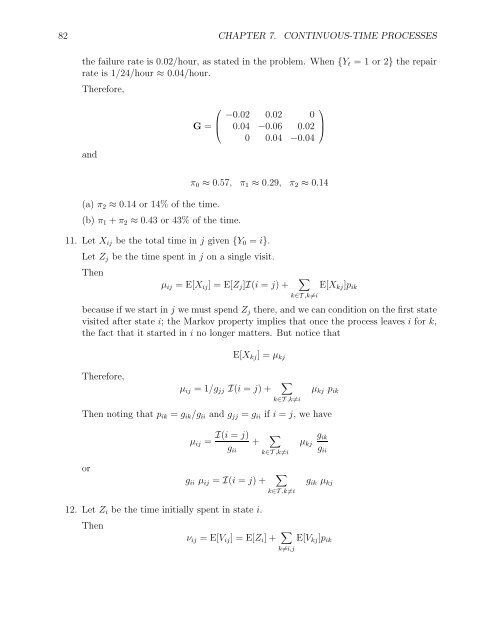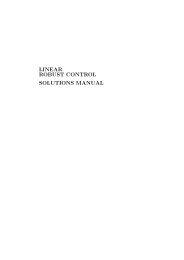SOLUTIONS MANUAL for Stochastic Modeling: Analysis and ...
SOLUTIONS MANUAL for Stochastic Modeling: Analysis and ...
SOLUTIONS MANUAL for Stochastic Modeling: Analysis and ...
Create successful ePaper yourself
Turn your PDF publications into a flip-book with our unique Google optimized e-Paper software.
82 CHAPTER 7. CONTINUOUS-TIME PROCESSES<br />
the failure rate is 0.02/hour, as stated in the problem. When {Y t =1or2} the repair<br />
rate is 1/24/hour ≈ 0.04/hour.<br />
There<strong>for</strong>e,<br />
<strong>and</strong><br />
⎛<br />
⎜<br />
G = ⎝<br />
−0.02 0.02 0<br />
0.04 −0.06 0.02<br />
0 0.04 −0.04<br />
⎞<br />
⎟<br />
⎠<br />
π 0 ≈ 0.57, π 1 ≈ 0.29, π 2 ≈ 0.14<br />
(a) π 2 ≈ 0.14 or 14% of the time.<br />
(b) π 1 + π 2 ≈ 0.43 or 43% of the time.<br />
11. Let X ij be the total time in j given {Y 0 = i}.<br />
Let Z j bethetimespentinj on a single visit.<br />
Then<br />
µ ij =E[X ij ]=E[Z j ]I(i = j)+ ∑<br />
k∈T ,k≠i<br />
E[X kj ]p ik<br />
becauseifwestartinj we must spend Z j there, <strong>and</strong> we can condition on the first state<br />
visited after state i; the Markov property implies that once the process leaves i <strong>for</strong> k,<br />
the fact that it started in i no longer matters. But notice that<br />
E[X kj ]=µ kj<br />
There<strong>for</strong>e,<br />
µ ij =1/g jj I(i = j)+ ∑<br />
k∈T ,k≠i<br />
µ kj p ik<br />
Then noting that p ik = g ik /g ii <strong>and</strong> g jj = g ii if i = j, wehave<br />
µ ij =<br />
I(i = j)<br />
g ii<br />
+ ∑<br />
k∈T ,k≠i<br />
µ kj<br />
g ik<br />
g ii<br />
or<br />
g ii µ ij = I(i = j)+<br />
∑<br />
k∈T ,k≠i<br />
g ik µ kj<br />
12. Let Z i be the time initially spent in state i.<br />
Then<br />
ν ij =E[V ij ]=E[Z i ]+ ∑<br />
E[V kj ]p ik<br />
k≠i,j















